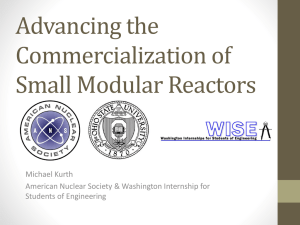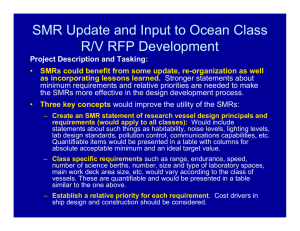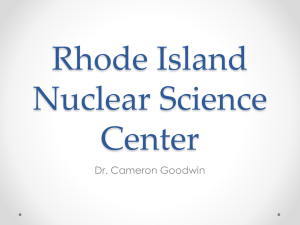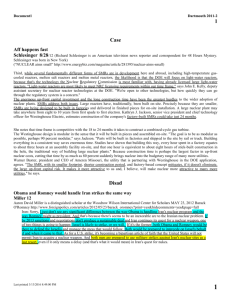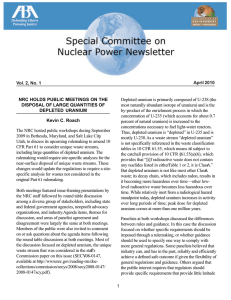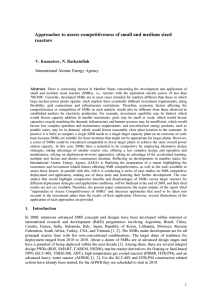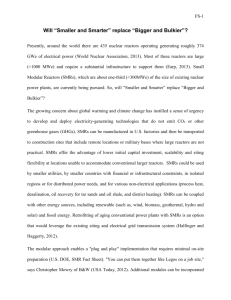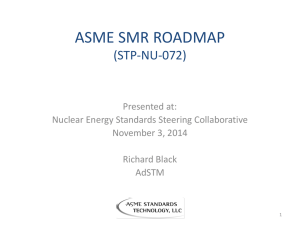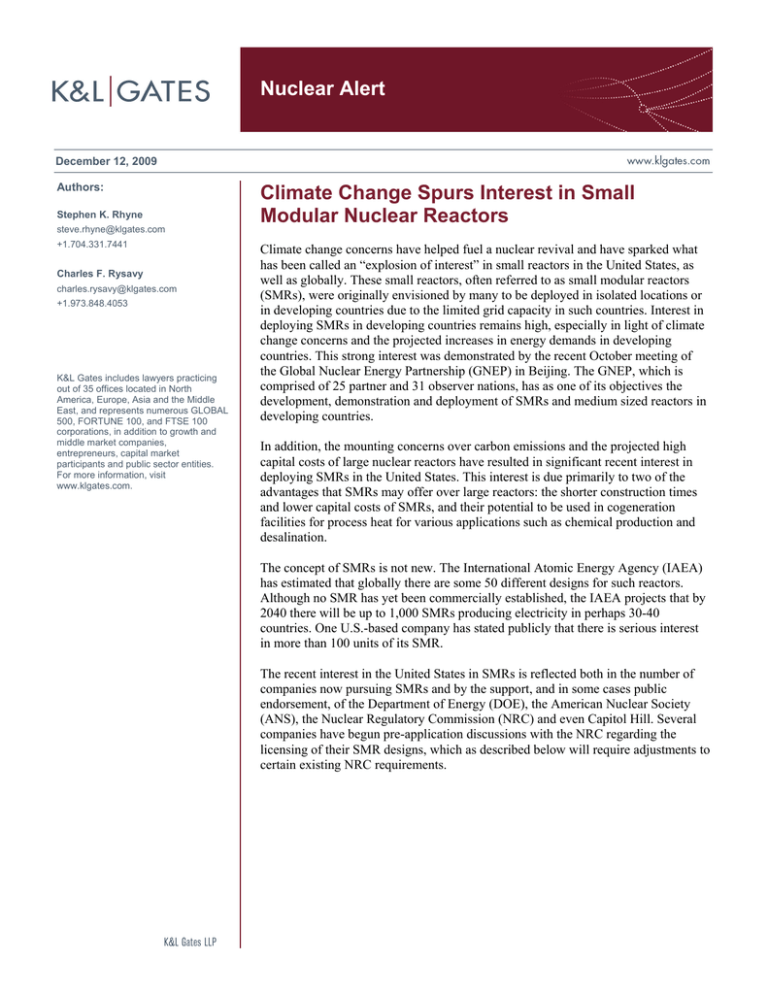
Nuclear Alert
December 12, 2009
Authors:
Stephen K. Rhyne
steve.rhyne@klgates.com
+1.704.331.7441
Charles F. Rysavy
charles.rysavy@klgates.com
+1.973.848.4053
K&L Gates includes lawyers practicing
out of 35 offices located in North
America, Europe, Asia and the Middle
East, and represents numerous GLOBAL
500, FORTUNE 100, and FTSE 100
corporations, in addition to growth and
middle market companies,
entrepreneurs, capital market
participants and public sector entities.
For more information, visit
www.klgates.com.
Climate Change Spurs Interest in Small
Modular Nuclear Reactors
Climate change concerns have helped fuel a nuclear revival and have sparked what
has been called an “explosion of interest” in small reactors in the United States, as
well as globally. These small reactors, often referred to as small modular reactors
(SMRs), were originally envisioned by many to be deployed in isolated locations or
in developing countries due to the limited grid capacity in such countries. Interest in
deploying SMRs in developing countries remains high, especially in light of climate
change concerns and the projected increases in energy demands in developing
countries. This strong interest was demonstrated by the recent October meeting of
the Global Nuclear Energy Partnership (GNEP) in Beijing. The GNEP, which is
comprised of 25 partner and 31 observer nations, has as one of its objectives the
development, demonstration and deployment of SMRs and medium sized reactors in
developing countries.
In addition, the mounting concerns over carbon emissions and the projected high
capital costs of large nuclear reactors have resulted in significant recent interest in
deploying SMRs in the United States. This interest is due primarily to two of the
advantages that SMRs may offer over large reactors: the shorter construction times
and lower capital costs of SMRs, and their potential to be used in cogeneration
facilities for process heat for various applications such as chemical production and
desalination.
The concept of SMRs is not new. The International Atomic Energy Agency (IAEA)
has estimated that globally there are some 50 different designs for such reactors.
Although no SMR has yet been commercially established, the IAEA projects that by
2040 there will be up to 1,000 SMRs producing electricity in perhaps 30-40
countries. One U.S.-based company has stated publicly that there is serious interest
in more than 100 units of its SMR.
The recent interest in the United States in SMRs is reflected both in the number of
companies now pursuing SMRs and by the support, and in some cases public
endorsement, of the Department of Energy (DOE), the American Nuclear Society
(ANS), the Nuclear Regulatory Commission (NRC) and even Capitol Hill. Several
companies have begun pre-application discussions with the NRC regarding the
licensing of their SMR designs, which as described below will require adjustments to
certain existing NRC requirements.
Nuclear Alert
provide funding for research on SMRs with the
goal of reducing nuclear reactor costs.
U.S. Interest in SMRs Increases
After publicly indicating only a year ago its
reluctance to address SMR licensing issues [PDF],
the NRC in 2009 undertook several initiatives that
are predicates to the licensing of SMRs in the United
States. Foremost among these was a two-day
workshop on October 8 and 9, 2009 with
stakeholders to discuss the generic issues associated
with the licensing of SMRs. At its workshop, the
NRC noted that it will hold additional workshops
beginning in early 2010 and will coordinate the
formation of an industry group to assist in
developing regulations for the licensing of SMRs.
Richard Black, of the DOE's Office of Nuclear
Energy, emphasized at the conference that DOE is
prepared to devote substantial attention to bolstering
the development of such reactors, including costsharing of research and development and NRC
licensing fees. He also announced that DOE will
hold a workshop in 2010 on funding opportunities
for SMRs. The Nuclear Energy Institute (NEI),
which is working with the NRC to form the SMR
industry group, also participated in the NRC
workshop. In addition to expressing its support for
the development of SMRs, the NEI announced that it
would be holding an SMR conference in February
2010.
Similarly, in 2009 the American Nuclear Society
(ANS), both at its meetings and in the columns of its
new president in the ANS newsletter, highlighted the
important role of SMRs in the nuclear industry.
Several sessions of the ANS biannual meeting this
past November, for example, were devoted to the
status and licensing of SMRs, plus the theme for the
ANS President’s Special Session was “Global
Opportunities for Right-Sized Reactors”. At the
meeting, the ANS announced that SMRs will be a
focus at its upcoming Annual Meeting in June 2010.
Members of the U.S. Senate also have recently
demonstrated their interest in the development and
deployment of SMRs in the United States. The
following three bipartisan Senate bills to amend the
Energy Policy Act of 2005 have been introduced
during the past two months:
•
Senate Bill 2052, the Nuclear Energy Research
Initiative Improvement Act of 2009, was
introduced on October 29, 2009 and would
•
Senate Bill 2812, The Nuclear Power 2021 Act,
was introduced on November 20, 2009 and
would establish a program to achieve the goal
of designing and certifying two SMR designs
by 2018 with the SMRs themselves to be
operational by 2021.
•
Senate Bill 2776, The Clean Energy Act of
2009, was introduced on November 16, 2009
and would mandate a number of nuclear and
other clean energy policy initiatives, including
funding to support license reviews for SMR
designs.
These SMR legislative proposals are in addition to
any that may be included in the bipartisan nuclear
title being crafted by Senators John Kerry, Lindsey
Graham and Joe Lieberman that is to be added to
the Senate’s climate and energy bill.
SMR Characteristics and SMR
Advantages
SMRs are relatively small in power output, on the
order of 25 megawatts electrical (MWe) to 350
MWe, as compared to large-scale reactors that can
have a power output of more than 1,200 MWe.
SMR designs are typically compact and several are
integral designs, with the steam generator and
pressurizer housed in the same vessel as the reactor.
Most designs have inherent and passive safety
features. In addition, two of the chief safety risks of
large reactors—the buildup of decay heat and
breakage of major piping in the primary loop—are
of significantly less concern in SMRs. Unlike
traditional reactors, some SMRs would be
manufactured and assembled at the factory and
shipped to the site as a nearly complete unit. Most
SMRs also would either require no refueling or have
long intervals between refuelings. As a result of
these characteristics, SMRs are expected to offer the
following advantages:
•
Shorter construction times and reduced capital
costs due to their smaller size, simpler designs
and, in some cases, complete factory assembly.
•
The alternative of smaller, incremental
additions to baseload electrical production due
to their smaller output. Such incremental
December 12, 2009
2
Nuclear Alert
additions are often desirable from a financial
standpoint or because of reduced transmission
costs or grid management concerns.
•
The latitude to increase electrical output as
needed by installing more SMRs and linking
them at a multi-modular site.
•
The capability of being cogeneration sources for
process heat due to their size and output, safer
designs and siting flexibility, including closer
proximity to the production or processing
facility. The range of cogeneration applications
includes desalination, chemical and hydrogen
production, petroleum refineries, and the
extraction of oil from tar sands.
•
More proliferation-resistant safeguards due to
their longer refueling intervals and, in some
cases, factory assembly and factory-to-site
shipment. This proliferation resistance, along
with the simplified operations of SMRs, could
be of critical importance for the broad
deployment of SMRs in developing countries.
For the reasons indicated above, SMRs may serve as
ideal power sources for discrete locations that
require an uninterruptible source of power
independent of the electrical grid. These would
include remote locations unconnected to the grid or
key military installations. The recently passed
National Defense Authorization Act (PL 111-84)
requires that a study be conducted on the feasibility
of building new reactors at military sites, in part
because of the “potential energy security
advantages” of not being dependant on the grid in
times of war or natural disaster.
NRC Licensing Considerations
Most SMRs are not merely scaled down versions of
large-scale reactors, but are new in design, siting,
construction, operation and decommissioning. The
legal and regulatory issues associated with these
units thus are not merely scaled down versions of the
issues faced by their much larger brethren. The
NRC’s new reactor licensing regulations in 10
C.F.R. Part 52 are designed to provide a more
streamlined process for new generation large-scale
reactors. Some facets of this new process will be
equally advantageous to SMRs, while others will
range from unnecessarily cumbersome to nearly
unworkable when applied to the licensing,
construction and operation of SMRs. Creative
navigation of the existing regulations by both the
NRC and licensees will solve some problems, but
others can be solved only by amending the
regulations.
For example, under 10 C.F.R. Part 171 the NRC’s
annual fee to operate each licensed nuclear reactor
is $4.5 million, an amount that would pose financial
problems for the development of many SMRs. In
March 2009 the NRC published an advanced notice
of proposed rulemaking that contemplates a variable
fee structure based on thermal limits for each power
reactor. (74 FR 12735; March 25 2009). This or a
similar change will be necessary to make SMRs
financially viable. Likewise, the size of the
decommissioning fund, insurance and other liability
issues could make SMRs uneconomical if not
tailored to the smaller units. Moreover, the form of
the combined operating and construction license
(COL) must take into consideration that certain sites
will initially host a single SMR but with the plan to
add multiple SMRs later as electricity demand
grows. Flexibility is one of the primary benefits of
SMRs, and the governing regulatory structure most
allow (and preferably embrace) that flexibility,
while simultaneously ensuring the safety of these
reactors, including any risks from interactions
between SMR units at a multi-modular site.
Another issue to consider is that the current
Emergency Planning Programs, based on the size of
existing large-scale reactors, require a 10-mile
Emergency Planning Zone (EPZ) for all reactors.
This requirement is almost certainly unjustifiable
for an SMR. These smaller reactors are much less
powerful, have safer designs and in many cases the
actual containment/reactor system will be placed
underground. A smaller EPZ is not without
precedent. The NRC required only a two-mile EPZ
for large-scale reactors prior to the Three Mile
Island accident in 1979.
Another aspect of SMRs that will require new, or
substantially revised, regulations is the likely
combination of the SMR power generation system
with the process heat applications in cogeneration
facilities. Proper consideration will need to be given
to ensuring that potential accidents at the production
December 12, 2009
3
Nuclear Alert
or processing portion of the facility do not adversely
affect the safe operation of the SMR.
Other characteristics of the proposed SMRs will
create unique legal and regulatory challenges,
including: import/export requirements for
technology, materials and equipment; design
certification; operating license restrictions; accident
consequence analysis; maintenance programs;
environmental programs; safeguards and security;
non-proliferation; foreign country regulations;
foreign ownership; IAEA standards; Price Anderson
Act; insurance and liability; financial qualifications;
decommissioning funding; license duration;
inspection programs; and staffing, especially for
passive operation plants.
Regulatory resources present one of the greatest
challenges to a robust SMR program in the United
States. The NRC, which has begun pre-application
discussions with several SMR companies, is already
overburdened working on the licensing of a number
of large-scale reactors. Even if the recent
congressional interest results in greater funding for
SMR reviews by the NRC, the NRC will still need
to hire a number of additional personnel to conduct
such reviews, a significant challenge in light of the
current shortage of nuclear engineers and
technicians. DOE has a special and possibly
essential role in helping to overcome the regulatory
challenges. Encouragingly, DOE has stated that it
intends to support the industry’s efforts to bring
SMRs to domestic markets. Included among DOE’s
proposed efforts is a cost-share partnership for firstof-a-kind SMR design and licensing that may be
initiated as early as 2011. DOE also intends to work
with the NRC and the industry to evaluate unique
licensing issues for SMRs, and to work on
enhancing the regulatory framework and licensing
process with the NRC.
Anchorage Austin Beijing Berlin Boston Charlotte Chicago Dallas Dubai Fort Worth Frankfurt Harrisburg Hong Kong London
Los Angeles Miami Moscow Newark New York Orange County Palo Alto Paris Pittsburgh Portland Raleigh Research Triangle Park
San Diego San Francisco Seattle Shanghai Singapore Spokane/Coeur d’Alene Taipei Tokyo Washington, D.C.
K&L Gates includes lawyers practicing out of 35 offices located in North America, Europe, Asia and the Middle East, and represents numerous
GLOBAL 500, FORTUNE 100, and FTSE 100 corporations, in addition to growth and middle market companies, entrepreneurs, capital market
participants and public sector entities. For more information, visit www.klgates.com.
K&L Gates is comprised of multiple affiliated entities: a limited liability partnership with the full name K&L Gates LLP qualified in Delaware and
maintaining offices throughout the United States, in Berlin and Frankfurt, Germany, in Beijing (K&L Gates LLP Beijing Representative Office), in
Dubai, U.A.E., in Shanghai (K&L Gates LLP Shanghai Representative Office), in Tokyo, and in Singapore; a limited liability partnership (also named
K&L Gates LLP) incorporated in England and maintaining offices in London and Paris; a Taiwan general partnership (K&L Gates) maintaining an
office in Taipei; a Hong Kong general partnership (K&L Gates, Solicitors) maintaining an office in Hong Kong; and a Delaware limited liability
company (K&L Gates Holdings, LLC) maintaining an office in Moscow. K&L Gates maintains appropriate registrations in the jurisdictions in which its
offices are located. A list of the partners or members in each entity is available for inspection at any K&L Gates office.
This publication is for informational purposes and does not contain or convey legal advice. The information herein should not be used or relied upon
in regard to any particular facts or circumstances without first consulting a lawyer.
©2010 K&L Gates LLP. All Rights Reserved.
December 12, 2009
4

